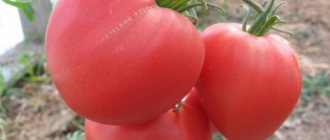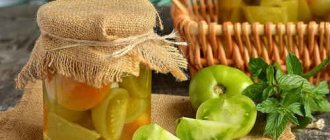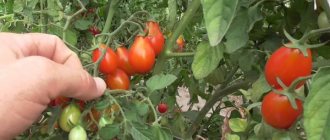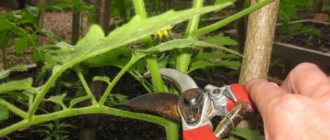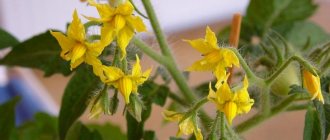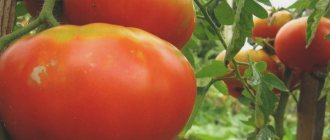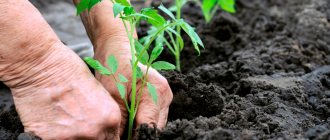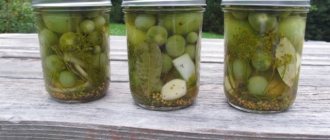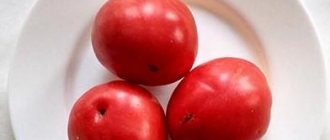Determinate variety of tomatoes: what is it?
It is quite simple to determine what a determinant type is - these are plants that, at one stage of the growing season, stop growing in height. This feature allows the bushes to redirect nutrients to inflorescences or fruits, instead of wasting them on a set of green mass. However, this may activate the lateral shoots, which enhance the bushiness of the tomatoes.
Typically, determinate tomatoes stop growing after the flower clusters appear. The top of the main stem of the bush ends in an inflorescence.
The average height of plants of this variety is 0.8 m. There are several subtypes of determinate tomatoes:
- semi-determinate;
- superdeterminant;
- standard.
Subtypes differ both in the maximum height of the bushes and in the principle of branching. This means that plants need different care and formation during the growing season.
Determinism
Inexperienced gardeners, reading the description of the variety, are at a loss as to what this word stated in the description means.
What does determinate tomatoes mean?
What does this mean? Growth is limited by the appearance of a flower cluster, on which flowers will first appear and then fruits will set. Further growth will occur from a strong stepson , which will appear from the axil of the leaf located immediately under the brush at the top of the bush.
Determinate variety of tomatoes
Determinate tomatoes are also divided into:
- Semi-determinate - includes varieties and hybrids with an intermediate type of branching;
- Superdeterminant - this includes a group of early ripening varieties;
- Super-super-determinate - this includes super early-ripening varieties with dwarf growth.
Indeterminate tomato
These are tall tomatoes that should be mechanically limited in growth. Since such a tomato vine grows up to 4 m in height. But since our warm season is short and tomatoes above the 2 m mark will not have time to ripen, the top is removed at this height.
Standard
These are industrial varieties of tomatoes that are grown in large areas for further sale or processing of tomatoes. They do not require garter, have a thick stem and the first fruits are obtained on the 75th day after the first shoots of seedlings.
Tomatoes of this type begin to ripen at the end of June .
Standard varieties are used for industrial cultivation; they are unpretentious
Semi-determinant
A tomato bush that does not stop at the meter height mark and continues to grow. But growth can stop at any moment. It is grown in two stems and is suitable for greenhouse conditions.
Semi-determinant
Stopping the growth of the bush does not mean that the tomatoes will be stunted. The semi-determinate variety stops growing not only at a level of 1 m, but also at a height of 2 meters. Inflorescences are formed after the 9th shoot. On average, 10 bunches of tomatoes ripen on a bush. Medium-sized seedlings can be planted directly in the garden, or grown indoors.
The transitional option combines the positive qualities of both determinate and indeterminate species:
- the first fruits ripen earlier than on full-size bushes;
- The harvest period is extended over several months.
Like tall-growing tomatoes, semi-determinate tomatoes require formation into 2 stems, pinching, and also tying to a trellis or piece supports.
Benefits of growing
Proper cultivation techniques will help unlock the many benefits of indeterminate tomatoes, especially when grown in a greenhouse.
It is advantageous to cultivate such varieties in a small area, since they form into 1 stem, sometimes 2. With this formation, the plant is a tall shoot, hung with clusters of fruits, which is very convenient for a small area. A narrow strip of planting takes up little space.
Slender rows of tall tomatoes
Attention! It is especially good to grow such varieties in a greenhouse. They are easy to guide along a rope stretched between the roof and the ground surface.
Superdeterminant
A low-growing variety with early ripening is called superdeterminate. The first tomatoes appear 50-60 days after planting, and the growth of the bushes stops after the appearance of 4 clusters. Every 2 shoots an inflorescence is formed, which allows you to harvest a good harvest.
Flowering, ovary formation and ripening of all tomatoes occur simultaneously. Therefore, it is better to use a super-determinant variety of tomatoes for canning or preparing preparations.
Bushes can be grown both indoors and outdoors, depending on the region or climatic conditions. There is no need to shape plants, prune shoots or install supports.
Super-determinate hybrids with early fruiting and resistance to fungal infections are popular.
Standard
The “standard variety” mark on the package means that the tomato will be short and compact. Externally, the plants resemble short trees with a powerful main stem, strong roots and a branched lush crown. Compact, strong bushes tolerate replanting well, do not respond to moderate temperature changes and require less space for growth.
The standard type absorbs moisture from the soil faster and also absorbs fertilizers more actively. Caring for such plants is much simpler; stepsons do not form in the axils of the leaves, and support for supporting the brushes is not needed. Tomatoes are resistant to pests, fungal and bacterial infections.
Despite the low yield, most varieties intended for industrial cultivation correspond to the standard type.
The fruits ripen simultaneously, 70-75 days after emergence. Tomatoes have an attractive presentation, are stored for a long time, and are easy to transport.
Selecting a type depending on the region
When thinking about choosing a variety, a gardener proceeds not only from his preferences regarding the early maturity of the crop, the shape, size and taste of the fruit. It is important to correlate the quality characteristics of the variety with the climatic conditions of the growing region. A mistake at this point can have fatal consequences for the future harvest.
Indeterminate tomatoes are famous for their productivity. However, they ripen a month later than determinate varieties. Taking into account this feature, it is necessary to decide on the placement of seedlings on the site. The warm and moderately humid climate of the southern regions of the country makes it possible to successfully grow such tomatoes both in a greenhouse and in open beds. Beyond the Urals and in central Russia, greenhouse cultivation is preferable.
In northern latitudes, standard varieties are becoming the only alternative to completely abandoning the cultivation of indeterminate tomatoes. Low-growing, with a strong thick stem, standard tomatoes are resistant to the vagaries of the weather and require minimal care.
Their happy owners are freed from the tedious chores of tying and pinching bushes. And the fruits will be pleased with early ripeness at the end of June. They tolerate long-term storage and transportation well.
Most determinate varieties are adapted to open and closed types of soil. They take root well in any climate zone of our country. But in conditions of short and cold summers, it is better to grow them in greenhouses.
Advantages and disadvantages of determinate tomatoes
The main advantage of determinate varieties is the limited growth of the bushes, which makes it easier to grow tomatoes in unprotected soil or low greenhouses. Advantages of the short type:
- In temperate climates, as well as in regions with short summers, a determinate plant allows you to get an early harvest.
- The fruits are characterized by uniform size and good taste.
- Vegetables ripen at the same time.
- The bushes do not need pinching or shaping; they are easier to care for.
The disadvantages of the determinant type include:
- the need for enhanced mineral supplements;
- overall yield indicators are lower than those of tall varieties;
- reduced immunity.
Popular determinate varieties
Many determinate type tomatoes deserve attention, including:
- Tomatoes Openwork. The hybrid begins to bear fruit on the 110th day. The red, round, large fruits are characterized by a sweet taste and universal use.
- The pride of Siberia. The determinate variety of tomatoes is suitable for unstable climates; the fruits ripen 120 days after sowing. Round, slightly flattened red tomatoes can gain up to 0.9 kg of weight. The plant is also resistant to fungal infections.
- Tomato Novichok. The variety has been popular for decades due to its high yield and early onset of fruiting.
- Oak. Super early tomatoes can be harvested after 3 months. The determinate tomato Oak is suitable for open ground and does not require special care.
- Honey cream. The standard cultivar bears fruit after 3 months. Small-sized vegetables attract with their elegant oblong shape and rich, sweet taste of the pulp.
- Severenok. A highly productive hybrid suitable for growing in cold climates; the first tomatoes will ripen by 85 days after planting.
- Amber. A standard variety with small yellow round fruits.
- Merchant. The lightweight hybrid tomato is suitable for all types of shelter; up to 16 kg of crop can be harvested per square meter, even in open ground.
Indeterminate tomato variety: what is it?
Unlike determinate ones, this type of bush does not stop growing the central stem, reaching a height of 2 to 6 m. Tall indeterminate tomatoes can be grown in greenhouses all year round, since the growing season of plants is much longer than that of short ones. To support the stems, different types of trellises or supports are used, to which climbing tomatoes will have to be tied. A large area is not needed for the growing season; 0.3 m² per each is enough.
The formation of bushes is of particular importance for indeterminate varieties. The tops of plants can be pinched to stop growth, and excess shoots can be trimmed as the foliage thickens. An abundance of greenery will lead to a decrease in yield, and the fruits will not be able to gain sufficient weight, remaining small.
Determinate and indeterminate tomatoes: what is the difference
You can see the difference between a determinate and an indeterminate plant at any stage of the growing season:
- During flowering, the first cluster appears after 3 pairs of leaves in determinate tomatoes. Indeterminate ones form an inflorescence only after 8 or 9 shoots.
- Seedlings can be distinguished by the size of the cotyledon, which is up to 3 cm in low-growing varieties, and 3-5 cm in tall varieties.
- Differences in the number of fruit shoots: tomatoes with limited growth produce brushes every 2 leaves, indeterminate ones - every 3.
- A determinate bush ends in an inflorescence.
How to determine the type of tomato?
To determine the type of tomato, you must:
- at the stage of purchasing seeds, pay attention to the characteristics and description of the variety;
- carefully examine the tomato bush, paying attention to the location of the ovaries: after which leaf from the rhizome the first one is located, and at what interval they follow;
- look at the growth of the plant and the cluster of fruits on it;
- pay attention to the ripening time of tomatoes.
Did you know? The record holder among tomato fruits was a tomato, whose weight was 2.9 kg. The giant was raised in the USA, Wisconsin.
Pros and cons of indeterminate tomatoes
It is worth determining which tomato is best to plant by considering all the pros and cons of the tall type. Among the advantages of indeterminate varieties:
- With proper formation, you can get a large tomato tree.
- The plant produces up to 50 brushes.
- Possibility of year-round fruiting.
- High total yield.
Unlimited growth is the main feature that distinguishes indeterminate tomatoes. This is also the most significant drawback of the species, which does not allow tomatoes to be grown outdoors in regions with short summers or lack of light.
Indeterminate varieties require support, constant formation, and pruning of stepsons, which significantly complicates plant care.
Advantages
- Bushes of this type are tall and are grown in one trunk, tied vertically to a support. This method increases the amount of harvest and guarantees approximately 16 kg. From one square meter;
- Tomato bushes are practically not exposed to diseases that are inherent in tomatoes; during cultivation, the lower leaf plates are removed before ripening tomatoes, and this increases the access of fresh air, which helps fight fungal diseases;
- Extended fruiting period - usually lasts until the first severe cold snap. In the southern regions of Russia, the end of fruiting can be considered the end of October;
- Care is quite simple , since this type of bush is cultivated in one stem, all stepsons are removed.
- Harvesting is simple for a summer resident ; there is no need to bend over or crawl on your knees.

